Uses a Contraceptive and Abortion
pg. 1
| Mother Earth Series: | ME 1 | ME 2 | ME 3 | ME 4 | ME 5 |
| Witches, Wiccans, Pagans Series: | WW3 1 | 2 | 3 | 4 | 5 | 6 | 7 | 8 | WW3 Ideology |
Visitors as of 5/10/2023
Understanding what I mean by "contraceptive" in relation to the idea of "Mother Earth" (as a planet) is easily grasped by looking at the evolution of the Earth and the absence of life. For example, the presence of Ice ages may or may not have kept life from forming (instead of being in a form of hibernation or other state of suspended animation), thus describing "Mother Earth" as being cold or frigid, in the sense we would apply to a woman who refrains from social encounters suggesting of a potential sexual event to occur. No less, a woman who is always on the move can not be pinned down long enough for a sexual event to occur either. Hence, a woman may use abstinence or activity as a form of contraceptive. A woman needn't use or take an oral contraceptive, an IUD (intrauterine device) or some spermatocide. However, the techniques used by a human woman in contrast to Mother Earth, need a bit of imagination in order to find parallel ideas taking place. Nonetheless, the disposition of Earth in the absence of life can be used as a general reference to the type of contraceptive or abortifacient being used.
Mother Earth is not the person whom you think she is if you are imagining her to be a kind, considerate, wise, loving, creative and otherwise full of virtue and life respecting entity. The ancient Greeks called her "Gaia" not because she had all the foregoing wonderful traits you might imagine a "good" person and mother to have; but because she was the creator of monsters and giants that we of today refer to as storms, earthquakes, lightning, sinkholes, floods, genetic mutations, poor soil conditions, misperception, etc...
Here is a list of recurring "threes-associated" off-spring with respect to the Gaea Mythology in Ancient Greece, though other cultures may have had their own terms and associated patterns that have not been itemized as have the Indo-European perspectives in different subject areas (Such as for example Georges Dumezil's Tripartite Ideology, and Fairy tales.):
- 3 Cyclops: Arges (Bright), Brontes (Thunderer), Steropes (Lightener), —who forged the thunderbolts of Zeus.
- 3 fates (Hora): (also called Destiny goddesses) Clotho (Spinner), Lachesis (Allotter), Atropos (Inflexible)
- 3 furies (Erinyes/ Eumenides): (also called Vengeance goddesses) Allecto ("Unceasing in Anger"), Tisiphone ("Avenger of Murder"), and Megaera ("Jealous")
- 3 Gorgon: Monster figure in Greek mythology. Homer spoke of a single Gorgon—a monster of the underworld. The later Greek poet Hesiod increased the number of Gorgons to three: Stheno (the Mighty), Euryale (the Far Springer), and Medusa (the Queen)—and made them the daughters of the sea god Phorcys and of his sister-wife Ceto. The Attic tradition regarded the Gorgon as a monster produced by Gaea, the personification of Earth, to aid her sons against the gods. ("Gorgon." Encyclopædia Britannica, 2013.)
- 3 Hecatoncheires: Briareus, also called Aegaeon... is one of the three brothers (in Greek mythology, he one of three 100-armed, 50-headed Hecatoncheires (from the Greek words for “hundred” and “hands”), the sons of the deities Uranus (Heaven) and Gaea (Earth). "Briareus." Encyclopædia Britannica, 2013.)
- 3 Hesperides: (Greek: "Daughters of Evening"); They were usually three in number, Aegle, Erytheia, and Hespere (or Hesperethusa), but by some accounts were as many as seven. ("Hesperides." Encyclopædia Britannica, 2013.)
- 3 apparent lovers of Gaea: Uranus (Heaven), Tartarus (Nether world), and as Themis she was the 2nd consort of Zeus (sky and weather god). However, she also is connected with Poseidon through Antaeus:
Antaeus
Please be aware that I am not particularly interested in Mythology or ancient religions... per se (like a preferred source of entertainment), since they remind me of television soap operas which I likewise have no interest in; but the underlying descriptive cognitive patterns provides us with some inkling as to how the human mind was in an ancient time; to be contrasted with other cultures in other time periods, including our own. This is not to say that a given writer reflects the common thought pattern of their day and age, but it does provide some indication if it can be found that the general public viewed the ideas similarly... such as in the case of worshipping a triad pantheon, though other cultures in the same era may not have done so, if only because of a lack of immersible contact.
In Greek mythology, a giant of Libya, the son of the sea god Poseidon and the Earth goddess Gaea. He compelled all strangers who were passing through the country to wrestle with him. Whenever Antaeus touched the Earth (his mother), his strength was renewed, so that even if thrown to the ground, he was invincible. Heracles, in combat with him, discovered the source of his strength and, lifting him up from Earth, crushed him to death.
Although many works of art from the Classical period show the wrestling match of Heracles and Antaeus, none earlier than a Hellenistic coin from Tarentum in Italy show Heracles lifting Antaeus. Ovid, in Metamorphoses, Book IX, is the first author to describe Antaeus's strength as coming from contact with the ground. (Antaeus." Encyclopædia Britannica, 2013.)
Present day uses of the word and idea associated with the "Mother Earth" theme are misplaced and are sorely in need of a revision from the simplistic notion being used by those in and out of the "WW3" (Witch, Wiccan, Pagan) orientations, as well as New Age preoccupations. In some cases the ideas being professed are feminine projections of what some women idolize about themselves or "womanhood"; if not having an infantile (being breast fed) association to the notion of "mother". While the ancient Greeks were more colorful in their descriptions of Natural forces, we of today need not indulge... and simply make a direct reference to the volcanic eruptions, earth-quakes, tornadoes, Tsunamis, heat waves, human failings, indiscretions, egotism, etc., produced by a Mother Nature that has no actual respect for life; much like a woman whose ability to give birth also makes her inclined to think she has a right to kill her offspring if she decides to because the offspring does not meet with her expectations. The idea that "Just as I gave them life, so too should I be able to take it", is a "much more" common (albeit generally unspoken) idea than one may want to think about.
Note: I am using the "WW3" symbol as a reference to the trio of Witches, Wiccans and Pagans. While the use of "Ws" may be easily understood by some, they might otherwise be unsure of why the "3" is being used to reference Pagans. My view is that Pagans pre-dated both Witches and Wiccans and that those who worshipped at Stonehenge might well be viewed as Pagans from our present day perspective, though during their own time they might well have been accepted as the High State of Governance by everyone in the community. Nonetheless, I am using the "3" to not only reference these early Pagans but also the formation of Stonehenge with its 3-stone (Trilithon) configuration represented as two upright stones topped by a third. The fact that the 3 symbols may also represent "World War III" in the mind's of some is assumed to me to reference a developing ideological war which will come to be pervasive and persuasive due to the increasing appreciation of how well wide-spread and deep the presence of a conserved cognitive "threeness" exists as a symbolic reference to incrementally deteriorating environmental events.
It is from the ancient Greek Poet Hesiod that we get an enlarged view of the mythologically defined theological beliefs as he saw them. (Most of the above list of "threes" is from Hesiod... or at least ideas attributed to him.) However, the use of "threes" by Hesiod needs to be reviewed in the larger context of cognitive development which can only be understood when one takes examples of "3s" (and the other small assortment of number patterns) from various subjects, in order to get a better grasp of how very small a circle the human mind is traversing in its conceptualizations and is a reference as to not only the conditions under which humanity has grow but is headed towards. It should also be note that while Hesiod saw "3s" Homer appears to have seen "1s". As someone writing in an earlier generation, the social and intellectual orientations of Homer's enculturations were apparently different, suggesting we are paying witness to a change in cognition. Although they both lived in Greek cultures, they were different enough... inter-generationally speaking, as to cause a shift in how ideas were being reported. Reporting gods as being singular in 1 generation and triplistic in another may seem to be an act of intellectual one-upmanship by some interpretations, but may otherwise be an indication in noting a cognitive trend which continues to this day. Both Homer and Hesiod played the part of being historical chroniclers, personal bloggers, as well as journalists.
For the moment, let us take a walk along the path of a description about Hesiod, and follow the footpath of entities which the linked-together story has inspired in different writers, all of which are not to become distractions from looking closely at the concept of Mother Earth; who becomes romanticized into something other than what she actually is. Far too many people of the present age have placed new garments on the Mother Earth theme which conceals her true Nature. She is a moody, violent and at times viscous person that, if she was a next door neighbor in human form, you would call for authoritative intervention and have her children taken into protective custody. As Mother Earth ages towards her eventual death (her death bed is already being warmed up), she will become more unstable not only due to the wrinkles (disintegrations) of her composition, but because her children have caused so much distress. And it can be claimed that she had an incestuous affair with Uranus, since she "produced" him. Unless one is going to claim that by "production" something related to magic or some divine ability, then the "mother" in Mother Earth had conceived of him as a birth, and not as some male portion of an hermaphroditic growth she cast off.
|
Uranus:, in Greek mythology, the personification of heaven. According to Hesiod's Theogony, Gaea (Earth), emerging from primeval Chaos, produced 1) Uranus, 2) the Mountains, and 3) the Sea. From Gaea's subsequent union with Uranus were born the Titans, the Cyclopes, and the Hecatoncheires. Uranus hated his offspring and hid them in Gaea's body. She appealed to them for vengeance, but Cronus (a Titan) alone responded. With the harpe (a style of sword called the scimitar, (thought to be a reflection of the Moon at a quarter phase) he removed Uranus' testicles as he approached Gaea. From the drops of Uranus' blood that fell on her were born the Furies, the Giants, and the Meliai (ash-tree nymphs). The severed genitals floated on the sea, producing a white foam, from which sprang the goddess of love, Aphrodite. Cronus by his action had separated Heaven and Earth. Uranus also had other consorts: Hestia, Nyx, Hemera, and Clymene. There was no cult of Uranus in classical Greece. This circumstance, together with the story's resemblance to Asian legends, suggests pre-Greek origins. The use of the harpe- points to an Asian source, and the story bears a close resemblance to the Hittite myth of Kumarbi. ("Uranus." Encyclopædia Britannica, 2013.) |
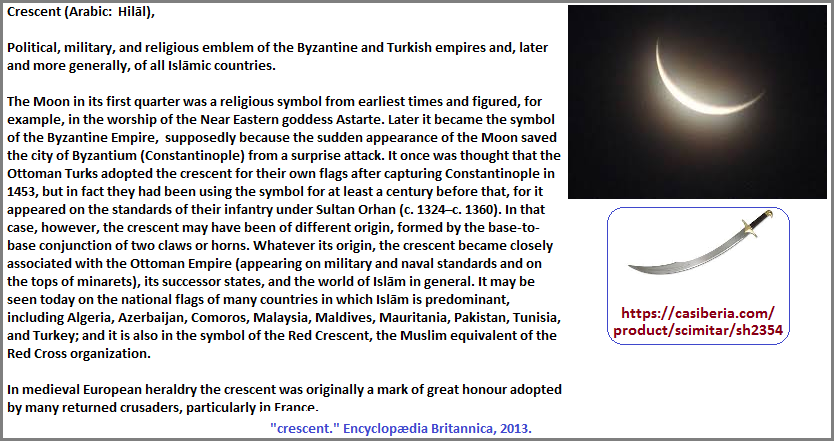
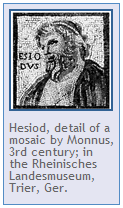
Hesiod:
Of Hesiod's two extant epics, the Theogony is clearly the earlier. In it, following the Muses' instructions, Hesiod recounts the history of the gods, beginning with the emergence of Chaos, Gaea (Earth), and Eros. Gaea gives birth to Uranus (Heaven), the Mountains, and Pontus (the Sea); and later, after uniting herself to Uranus, she bears many other deities. One of them is the Titan Cronus, who rebels against Uranus, emasculates him, and afterward rules until he in turn is overpowered by Zeus. This story of crime and revolt, which is the central subject of the Theogony, is interrupted by many additional pedigrees of gods.
Elsewhere, in addition to mythical family relations, Hesiod presents new ones that are the product of his own speculation. Thus, the names of the 50 sea maidens (the Nereids) fathered by the sea god Nereus indicate various qualities of the Sea. In a different way, the story describing the first woman, Pandora, sent by Zeus to bedevil man, brings out Hesiod's firm belief in the supreme and irresistible power of Zeus. This power is most majestically displayed in the Titanomachia, the battle between the Olympian gods, led by Zeus, and the Titans, who support Cronus.
Hesiod's authorship of the Theogony has been questioned but is no longer doubted, though the work does include sections inserted by later poets and rhapsodists. The story of Typhoeus' rebellion against Zeus was almost certainly added by someone else, while the somewhat overlapping accounts of Tartarus, the hymn on Hecate, and the progeny of the sea monster Keto are highly suspect. The discovery of a Hurrian theogony similar to Hesiod's seems to indicate that Hesiod's theogony owes significant episodes to Middle Eastern models. Nonetheless, the Uranus-Cronus-Zeus succession as told by Hesiod approximates the pattern of a classical Greek tragic trilogy. Thus, the Erinyes (the deities of vengeance) are born when Uranus is overthrown by Cronus, while their own hour for action comes when Cronus is about to be overthrown by Zeus. These and other similar features plausibly represent Hesiod's own contributions to the inherited story. ("Hesiod." Encyclopædia Britannica, 2013.)
Eros:
In Greek religion, god of love. In the Theogony of Hesiod (fl. 700 BCE), Eros was a primeval god, son of Chaos, the original primeval emptiness of the universe, but later tradition made him the son of Aphrodite, goddess of sexual love and beauty, by either Zeus (the king of the gods), Ares (god of war and of battle), or Hermes (divine messenger of the gods). Eros was a god not simply of passion but also of fertility. His brother was Anteros, the god of mutual love, who was sometimes described as his opponent. The chief associates of Eros were Pothos and Himeros (Longing and Desire). Later writers assumed the existence of a number of Erotes (like the several versions of the Roman Amor). In Alexandrian poetry he degenerated into a mischievous child. In Archaic art he was represented as a beautiful winged youth but tended to be made younger and younger until, by the Hellenistic period, he was an infant. His chief cult centre was at Thespiae in Boeotia, where the Erotidia were celebrated. He also shared a sanctuary with Aphrodite on the north wall of the Acropolis at Athens. (See also Cupid.) "Eros." Encyclopædia Britannica, 2013.
Cupid:
Ancient Roman god of love in all its varieties, the counterpart of the Greek god Eros and the equivalent of Amor in Latin poetry. According to myth, Cupid was the son of Mercury, the winged messenger of the gods, and Venus, the goddess of love. He often appeared as a winged infant carrying a bow and a quiver of arrows whose wounds inspired love or passion in his every victim. He was sometimes portrayed wearing armour like that of Mars, the god of war, perhaps to suggest ironic parallels between warfare and romance or to symbolize the invincibility of love.

Although some literature portrayed Cupid as callous and careless, he was generally viewed as beneficent, on account of the happiness he imparted to couples both mortal and immortal. At the worst he was considered mischievous in his matchmaking, this mischief often directed by his mother, Venus. In one tale, her machinations backfired when she used Cupid in revenge on the mortal Psyche, only to have Cupid fall in love and succeed in making Psyche his immortal wife. ("Cupid." Encyclopædia Britannica, 2013.)
Psyche, Greek "Soul":
In classical mythology, princess of outstanding beauty who aroused Venus' jealousy and Cupid's love. The fullest version of the tale is that told by the 2nd-century-AD Latin author Apuleius in his Metamorphoses, Books IV–VI (The Golden Ass).
According to Apuleius, the jealous Venus commanded her son Cupid (the god of love) to inspire Psyche with love for the most despicable of men. Instead, Cupid placed Psyche in a remote palace where he could visit her secretly and, by his warning, only in total darkness. One night Psyche lit a lamp and found that the figure at her side was the god of love himself. When a drop of oil from the lamp awakened him, he reproached Psyche and fled. Wandering the earth in search of him, Psyche fell into the hands of Venus, who imposed upon her difficult tasks. Finally, touched by Psyche's repentance, Cupid rescued her, and, at his instigation, Jupiter made her immortal and gave her in marriage to Cupid. The sources of the tale are a number of folk motifs; the handling by Apuleius, however, conveys an allegory of the progress of the Soul guided by Love, which adhered to Psyche in Renaissance literature and art. In Greek folklore the soul was pictured as a butterfly, which is another meaning of the word psyche. ("Psyche." Encyclopæædia Britannica, 2013.)
By studying mythology, you may eventually come to a reference noted as "Great Mother":
Great Mother of gods, also called Cybele, Cybebe, or Agdistis:
Ancient Oriental and Greco-Roman deity, known by a variety of local names; the name Cybele or Cybebe predominates in Greek and Roman literature from about the 5th century BC onward. Her full official Roman name was Mater Deum Magna Idaea (Great Idaean Mother of the Gods).
Legends agree in locating the rise of the worship of the Great Mother in the general area of Phrygia in Asia Minor (now in west-central Turkey), and during classical times her cult centre was at Pessinus, located on the slopes of Mount Dindymus, or Agdistis (hence her names Dindymene and Agdistis). The existence, however, of many similar non-Phrygian deities indicates that she was merely the Phrygian form of the nature deity of all Asia Minor. From Asia Minor her cult spread first to Greek territory. The Greeks always saw in the Great Mother a resemblance to their own goddess Rhea and finally identified the two completely.
During Hannibal's invasion of Italy in 204 BC, the Romans followed a Sibylline prophecy that the enemy could be expelled and conquered if the “Idaean Mother” were brought to Rome, together with her sacred symbol, a small stone reputed to have fallen from the heavens. Her identification by the Romans with the goddesses Maia, Ops, Rhea, Tellus, and Ceres contributed to the establishment of her worship on a firm footing. By the end of the Roman Republic it had attained prominence, and under the empire it became one of the most important cults in the Roman world.
In all of her aspects, Roman, Greek, and Oriental, the Great Mother was characterized by essentially the same qualities. Most prominent among them was her universal motherhood. She was the great parent not only of gods but also of human beings and beasts. She was called the Mountain Mother, and special emphasis was placed on her maternity over wild nature; this was manifested by the orgiastic character of her worship. Her mythical attendants, the Corybantes, were wild, half-demonic beings. Her priests, the Galli, castrated themselves on entering her service. The self-mutilation was justified by the myth that her lover, the fertility god Attis, had emasculated himself under a pine tree, where he bled to death. At Cybele's annual festival (March 15–27), a pine tree was cut and brought to her shrine, where it was honoured as a god and adorned with violets considered to have sprung from the blood of Attis. On March 24, the “Day of Blood,” her chief priest, the archigallus, drew blood from his arms and offered it to her to the music of cymbals, drums, and flutes, while the lower clergy whirled madly and slashed themselves to bespatter the altar and the sacred pine with their blood. On March 27 the silver statue of the goddess, with the sacred stone set in its head, was borne in procession and bathed in the Almo, a tributary of the Tiber River.
Cybele's ecstatic rites were at home and fully comprehensible in Asia, but they were too frenzied for Europeans farther west. Roman citizens were at first forbidden to take part in the ceremonies—a ban that was not removed until the time of the empire. Though her cult sometimes existed by itself, in its fully developed state the worship of the Great Mother was accompanied by that of Attis.
The Great Mother was especially prominent in the art of the empire. She usually appears with mural crown and veil, seated on a throne or in a chariot, drawn by two lions. (In some accounts, the lions were originally Atalanta and Hippomenes.)
Mother goddess figures are found in almost every ancient religion, but these figures, who were usually only goddesses of fertility and reproduction in general, should not be confused with the Great Mother of the Gods, who was regarded as the giver of life to gods, human beings, and beasts alike. ("Great Mother of the Gods." Encyclopædia Britannica, 2013.)
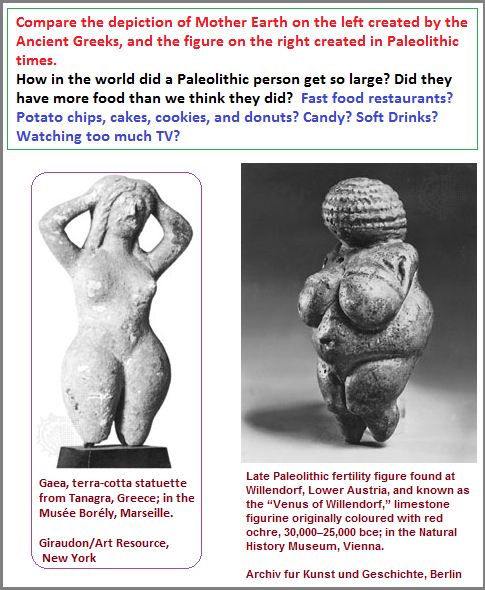
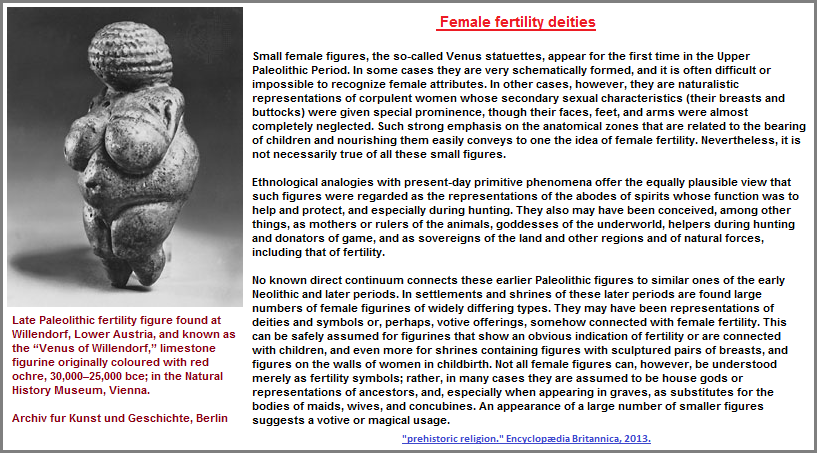
A reference to the Greek goddess Rhea was made in the foregoing script. Let us look at a caption about her:
Rhea:
In Greek religion, ancient goddess, probably pre-Hellenic in origin, who was worshipped sporadically throughout the Greek world. She was associated with fruitfulness and had affinities with Gaea (Earth) and the Great Mother of the Gods (also called Cybele). A daughter of Uranus (Heaven) and Gaea, she married her brother Cronus, who, warned that one of his children would be fated to overthrow him, swallowed his children Hestia, Demeter, Hera, Hades, and Poseidon soon after they were born. Rhea concealed the birth of Zeus in a cave on Mount Dicte in Crete and gave Cronus a stone wrapped in swaddling clothes. This he swallowed in the belief that it was Zeus. Subsequently, Cronus was vanquished by Zeus and was forced to disgorge the swallowed children. ("Rhea." Encyclopædia Britannica, 2013.)
Let us now turn away from mythology and religion to Look at Mother Earth as a planet:
For those who are not aware, the Early Earth had a much faster rotation rate in the distant past, thus exposing us to the thought that life occurs in a centrifugal environment (like bacteria in a test tube being spun in a centrifuge). In other words, the oceans and continents have changed over time due to a slowing of the Earth's rotation, and will continue to change accordingly. A fast speed concentrates everything into "sedimentations" while slower speeds allows for a more relaxed state, producing other concentrates and layerings, though in terms of a closed "ball" that the Earth is, there can only be a certain amount of spreading out before a compilation is once again achieved. In other words, the continents are predicted to become one mass again in the future. This is what the continents did as an attempted balancing act as they sloshed around in the formative oceans. Analogously, if you use a centrifuge in a laboratory, you have to place the test tubes in a manner that keeps the machine balanced, though the reader should note that Earth has a Chandler wobble, as part of the Polar motion variations, and thus describes the Earth's "test tubes" alignment being conducted by an Igor lab assistant who mis-aligns them.
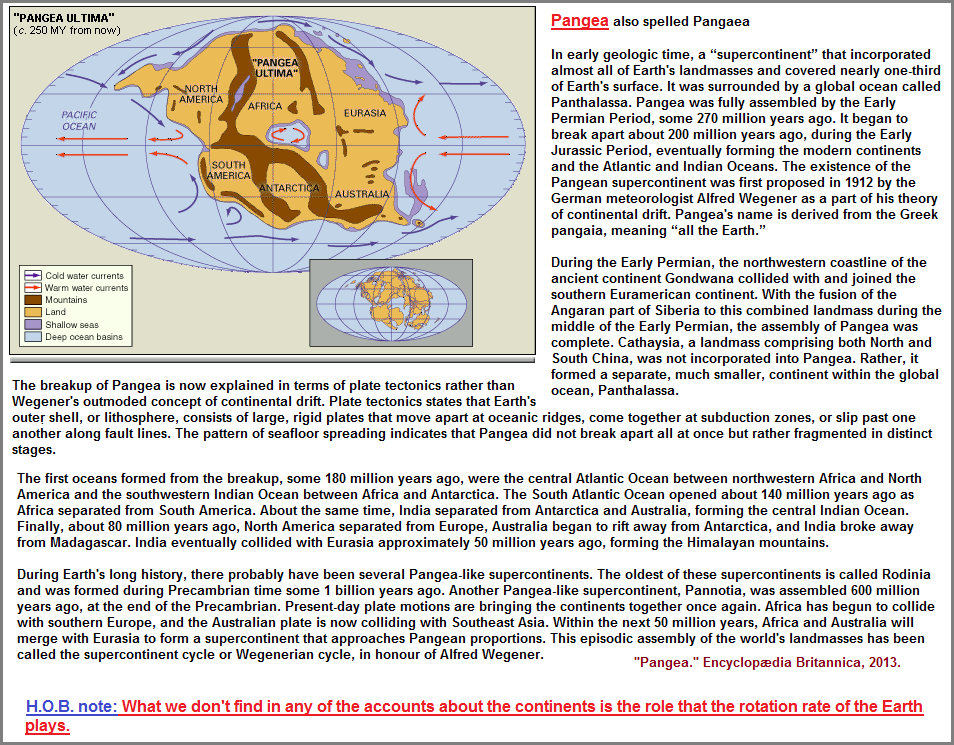
Whereas it is described that there was once a "Super-continent" long ago when the Earth's rotations was spinning faster, it is believed that there will once again be a super-continent in the distant future when the rotation rate of the Earth has slowed. However, it should be mentioned that there is no one speaking of the rate of the Earth's rotation in relation with the changes in the Earth's land masses and oceans. Changes in the continents is explained by the reference "Tectonic plate" movements, as if this is the primary reason instead of being a consequence! I have to laugh as I write this because it is so incredibly naive. I feel as if I have taken a trip back in time to some ancient past and have to deal with old ideas, customs and in general, so very much social nonsense in this Age of Irrationality.
Simply stated, Mother Earth had to slow down a bit before life's processes could begin. However, we also have the occasion where Mother Earth held her breath in terms of their being little to no oxygen, though if we look at RNA and DNA, it is the supposed later born DNA which has 1 oxygen molecule less, did not need it because there was more oxygen available. Hence the "Deoxy" in Deoxyribose nucleic acid means there was no need for the same mechanism of chemistry to be adopted. Later biological development didn't require the same number of oxygen molecules as RNA, since oxygen began to increase... most likely on those chemical stratification humans and other life forms of today would not be able to detect, but basic micro- and macro-molecules could billions of years ago.
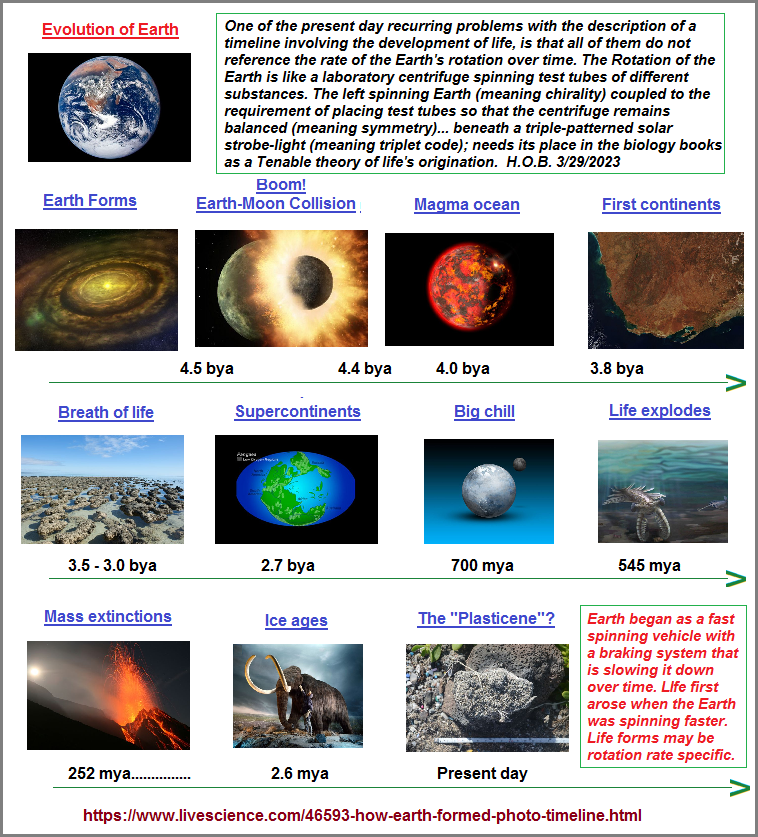
How the Earth developed is not necessarily how one would describe the development of a human fetus, though if we could enlarge the developmental processes
of life we might well see a parallel type of development which would erase the sentimentality parents have about a baby being slowly and lovingly "cooked" in
the oven (womb) like  a fragrant-full rising loaf of bread one can't wait to take pleasure in. In other words, if we could see the developmental processes of a human (or any life
form) on a planetary scale instead of a microscopic scale, our ideas about life might radically change. We do not think of development as a violent process,
similar to the violence the development of the Earth went through and continues to exhibit. Indeed, one can only imagine what sound(s) cells make as they
divide and multiply and then proceed towards a three Germ layer ensemble of differentiation.
a fragrant-full rising loaf of bread one can't wait to take pleasure in. In other words, if we could see the developmental processes of a human (or any life
form) on a planetary scale instead of a microscopic scale, our ideas about life might radically change. We do not think of development as a violent process,
similar to the violence the development of the Earth went through and continues to exhibit. Indeed, one can only imagine what sound(s) cells make as they
divide and multiply and then proceed towards a three Germ layer ensemble of differentiation.
However, let me admit that while analogies are sometimes entertaining and describe unforeseen parallels, the comparisons can be taken too far when one attempts to be too literal. However, in light of the fact that there are those who prefer to view the Earth as if it were a living being corresponding to a nurturing mother, let me engage in some alternative ideas about this so-called female planet expressed symbolically and ideologically as to suggest Mother Earth epitomizes not only motherhood but all things good, proper and perhaps even perfect in the vision of some people. And like any woman who has a childhood, let us attempt to create what was the early childhood of the Earth. Unfortunately, there is no family album placed nearby which provides an easily viewable record, thus we have to rely on clues based on the artefacts we find associated with geology and our knowledge of chemistry and those events which astronomers claim to have witnessed occurring with other planets. With this noted, let us be honest in saying we are simply supposing what we think such a beginning for Mother Earth was.
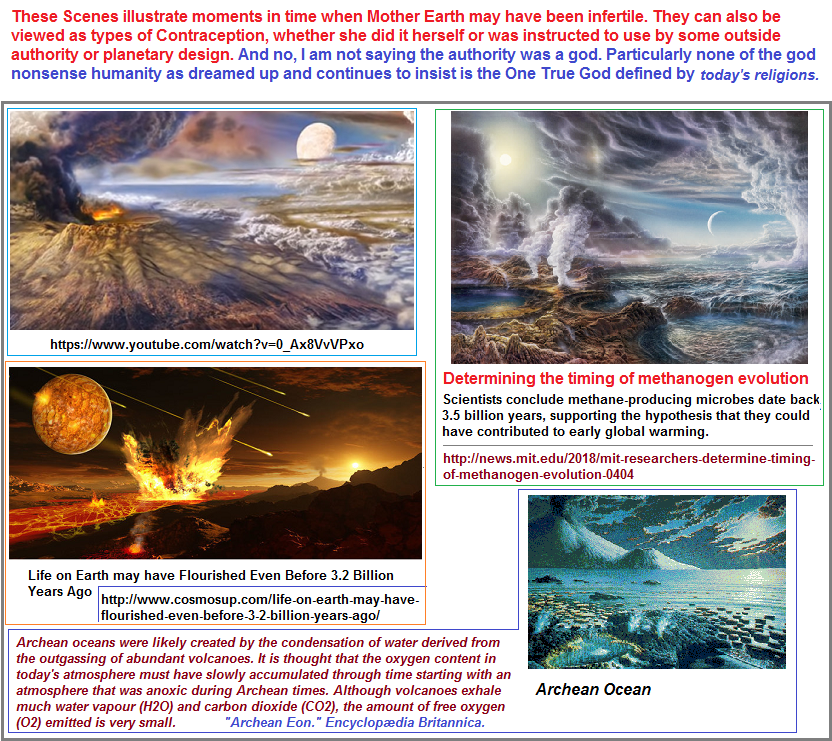
We actually do not know what the Earth was like, and are only making educated guesses. For example, what color... if any, was the sky and landscape, which might have affected how a beginning life form "saw" the Sun's radiating affects; a prominent one being photosynthesis? Was Mother Earth wearing rose tinted glasses like the hippies in the 1960s? Was Mother Earth on a methane high (Intoxication)? Was Mother Earth's first pregnancy due to being intoxicated?
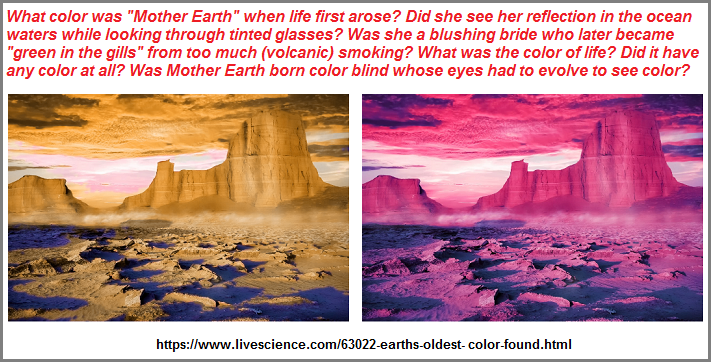
Since we are using the perspective of viewing the Earth as a "Mother", it is easily understood if I assign the developmental behavior of Earth (geology and meteorology, etc...) in human and human female terms of reference. It is called "anthropomorphism" when someone applies animate attributes to inanimate objects or activities. However, since the initial pages of this series is headed towards a larger discussion of the WW3 (Witches - Wiccans- Pagans), I am inclined to include a wider berth of information concerning the idea of "Mother Earth" as a symbolic reference to Nature worship and religion. As I see it, all Western religions and Eastern philosophies have roots in Nature worship which typically become obscured by symbolism. Yet, the view of the Earth as a mother and a Moon as a goddess (or as I see it, a hand maiden to the Earth), does not have the history of mixing, matching, and confiscation of ideas which Christianity, Islam, Judaism, etc., have engaged in. In other words, it is an idea that is more honest in describing its origins. However, we need to look at some parallels so as to understand the rationale that the present day practitioners of the WW3 are using and getting off track towards the direction they should be headed.
Date of Origination: Saturday 11th February, 2023... 4:46 AM
Initial Posting Date: Wednesday 10th May, 2023... 6:04 AM